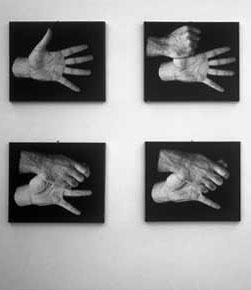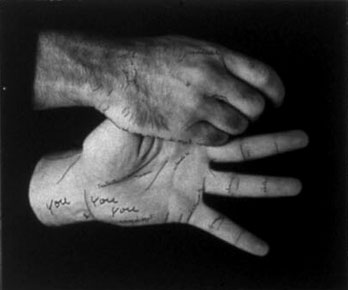| |
|||||||
|
|
Ketty La Rocca |
||||||
| |
|||||||
|
|
||||||
| |
|||||||
| Opening 5 June 2003, 7 pm Opening by Dr. Herta Arnold, Office of the Tyrolean Provincial Government, Department for Culture Dr. Silvia Eiblmayr will speak about the exhibition |
|||||||
| |
|||||||
|
Ketty La Rocca is one of the leading representatives of conceptual art in Italy. The oeuvre of the early deceased artist comprises visual poetry, visual art and performance. In her poetic, experimental and media-critical works, La Rocca explored the language, imagery and the stereotypical signs of everyday life. Her work was informed by her intention to visualize the dominant politics of bodies. The artist's earliest pieces are collages on which she began working in 1964. Already here she brings together in a striking way her political critique by means of which she testified to the revolutionary spirit of this period. The discussion at that time revolved around a society increasingly dominated and conditioned by consumption and the media. La Rocca adopted the approach of Pop Art, first acknowledging the stereotypical and trivial nature of the imagery of the media and of commodities and then confronting art with a social field which she not taken up her work before. In her anticipation of later critical concepts, La Rocca did not, however, endorse the generally affirmative character of Pop Art. In her "Poesia Visiva", she used sarcastic and poetic wit to undermine the promises that advertisement made to women. Images and slogans of the saturated world of consumption or of the church were mounted next to images from the so-called Third World and the war so as to reveal the ignorance of the West vis-à-vis other cultures or the victims. La Rocca also made use of the strategy of reifying the image or linguistic signs with regard to their clichés so as to thereby subvert their social conventions and to transform them into something else in individual letters or characters. A "J" or a comma would then be set free to become a sculpture, which in their strange isolation became metaphoric for the subject that was left to its own. In the 1970's La Rocca developed her performative series with hands. She studied their expressive potential, placing them in a linguistic context by writing words on the hand and adorning their contours with handwriting. Her interest in hands grew out of her desire to create a different form of communication in which the real body, gestural expression and writing relate to each other in a strange montage. In connection with theses works La Rocca made explicit reference to the life situation of women. Here the hands of women have only been assigned certain tasks. "For women today is not a time for explanations", she wrote in 1974 from her feminist perspective. "They have a lot to do but then they only have a one language that is alien and inimical to them. They have been robbed of everything, except for those things that no one takes note of and there are plenty of them, even if they must be ordered. Hands, for instance, too slow for female activities, too poor and to inept to continue hoarding. It is better to knit with words...". One of Ketty La Roccas latest works were the "Riduzioni", in which she "reworked" the everyday photograph, be it a family photo, a photo of a gallery installation, a photograph depicting her or a politician, a newspaper photograph, an art card that has been sold a million times or a film poster. The principle of "Riduzioni" consists in serially expanding the initial photograph in one or more variations. This can happen through graphic schematization of the image on the basis of two different approaches. Either the artist "traced" with her handwriting the contours of the forms that stroke her as important or she used lines or black marks to accentuate certain elements, which, like the handwriting, also resulted in an entirely new interpretation. La Rocca negated the difference between depth and surface as well as the hierarchy of scenic plot, placing the image in a tense state of suspension. In the interstices created by her, in the gaps, a poetic space emerged that also extended to the imagery of everyday life. The exhibition shows text images, objects, collages, conceptual photographic works and video of her performances. Ketty La Rocca was born in La Spezia in 1938 and died in Florence in 1976. Supported by
the Italian Cultural
Institute, Innsbruck |
|||||||
| |
|||||||
|
Catalogue
|
|||||||
| |
|||||||
|
|||||||

